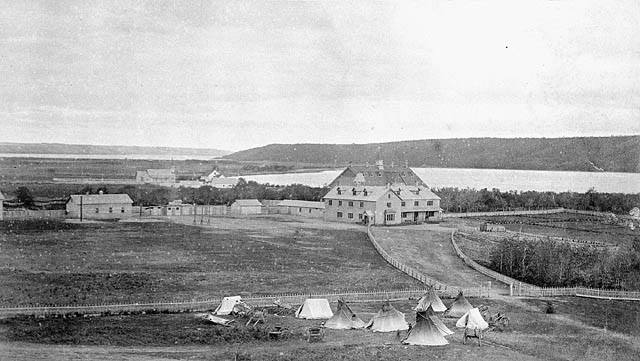WARNING: Disturbing content
The Star Blanket Cree Nation said it has discovered human remains in its search for unmarked residential school graves at the Qu’Appelle Industrial School, commonly referred to as the Lebret Indian Industrial school. The discovery of a jawbone fragment was made on October 2 by a security person.
Project lead Sheldon Poitras explained the fragment from the right side of the jaw was analyzed by the Saskatchewan Coroner’s Service. “It is a jaw bone fragment of a child between the ages of four and six,” said Poitras. “The bone fragment has been aged to about 125-years old, which puts us in the first school era.”
Poitras said the physical proof of an unmarked grave of a child at the turn of the 20th century.
“This discovery has changed everything. It’s changed our mindset and our way of life in a way,” Star Blanket Cree Nation Chief Michael Starr said. “We’ll bring honour to the remains, that of a young child. Now we know its proof. Its very significant that way.”
The location of the jawbone was in the front-yard of the first school, that being the Qu’Appelle Industrial school. Poitras said the area appears to be prepared for agricultural use, possibly a garden. However, he pointed to a map of the area suggesting there are no cemeteries around.
The jawbone fragment was placed in a teal-coloured box. That box was present at the press conference, placed directly in front of Chief Starr. The First Nation indicated the remains will be highly respected and traditional protocol will be observed in possible future next steps with the jawbone.
“That little baby, those bones, was someone’s child, someone’s grandchild. He or she was ripped from someone’s home, kidnapped,” said Federation of Sovereign Indigenous Nations Chief Bobby Cameron.
The Lebret Industrial School also known as the Qu’Appelle, St. Paul’s and Whitecalf, operated from 1884 to 1998. It was administered by the Roman Catholic Church. Pope Francis apologized in 2022 for the Church’s involvement in residential school. The Lebret school opened not long after the signing of Treaty 4. It is considered one of the first residential schools to open and one of the last to close.
In November, the First Nation undertook Phase One of its ground-penetrating radar project to search for unmarked graves. The search mainly comprised of flat areas around the former school grounds.
Poitras said there were more than 2000 detections. While that is an alarmingly high number, not all 2000 hits are expected to be human remains.
The First Nation will investigate all hits for possible remains, potentially using core drilling samples to test for DNA. It is expected that many of hits could be anomalies such as rocks, tree material or other matter.
“This is unprecedented. This is something we never thought we’d be doing,” explained Chief Starr.
Additional phases of searches will be undertaken on privately owned land. Poitras explained that some landowners are opening and willing to aid the First Nation in it search, while other are more reserved, yet optimistically suggesting diplomacy may persuade them into assisting.
Support is available for those affected by their experience at Indian Residential Schools and in reading difficult stories related to residential school. The Indian Residential School Crisis Line offers emotional and referral services 24 hours a day at 1-866-925-4419. In Saskatchewan, the Regina Treaty Status Indian Services at 306-522-7494.
